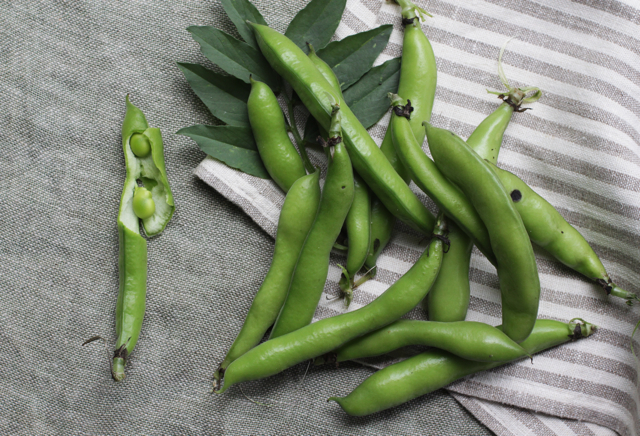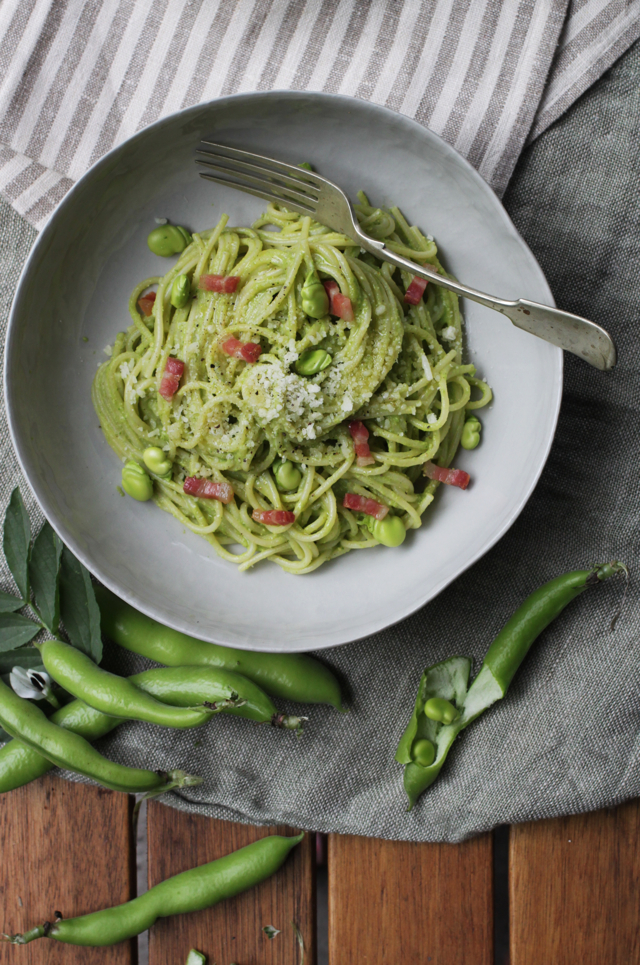I’m on a broad bean kick lately. The beans we planted five months ago have grown outgrageously. They’re taller than me and are producing lovely, long velvety fingers of pods, which all of us (the 11 month old bean-eater included) have been picking, opening and eating right there on the spot. They’re just so good like this when they’re young and tender that I’ve hardly had them any other way.

Broad beans (also known as fava beans, and in Italian known as fave or baccelli) are actually extremely versatile in the kitchen. Dried or fresh, they’re a staple legume in cultures all over the world from North Africa, the Middle East, South America to China. You’ll find them fried and salted to be popped in the mouth addictively like peanuts, mashed with olive oil, garlic and lemon, cooked whole in soups or braises, made into falafel or fritters, roasted, toasted, even made into flour. You can also eat the young, new leaves, cooked like spinach. The black and white flowers the plant produces are as tasty as they are pretty (they taste just like the beans) but be careful not to pick too many as they of course are to become your beans!
In Italy, other than eating them raw with some bitey Pecorino cheese and prosciutto, on mashed up a bit on a crostino, Roman vignarola is a beautiful way to experience the fleeting moment when broad bean season overlaps with artichoke season. The most southern part of Puglia also has an elemental dish of pureed dried broad beans served with wild chicory (known as fave e cicoria), a regional favourite.
They’re an ancient legume, which has been an important part of the Mediterranean diet for about 8,000 years, for good reason. They’re oh so easy to grow, even in a small patch of soil (note, plant your tomatoes where broad beans have grown, they actually add nitrogen to the soil that the other plants will love), they’re delicious and so adaptable in the kitchen. When you reap a big harvest like we just have, they can easily be podded and then frozen or even dried or you can give away armfuls to your friends.
What else to do with broad beans literally coming out of your ears? A pesto, of sorts. Some pecorino, pistachios (and, for a bit of extra colour, a handful of baby spinach), pounded and blended together. The pastel green puree is rather delicate, but goes hand in hand with some crisp pancetta, a scattering of grated pecorino cheese and whole raw broad beans dressing a long pasta like spaghetti.

Broad bean ‘pesto’
This is very much a dish that is thrown together with what’s around, not so much a recipe as it is an idea. You could substitute the pistachios for more traditional pine nuts or walnuts. The extra greens that are added to boost the colour are optional, as is the pancetta.
- Fresh broad beans
- A few slices of pancetta, chopped (optional)
- A handful of baby spinach leaves (or tender young broad bean leaves), for colour
- A handful of pistachios
- A handful of Pecorino cheese, grated
- Extra virgin olive oil, as needed
- Spaghetti or linguine (80 grams per person)
Pod the beans and blanch them to remove their skins if you have big, thumb-sized beans wearing white, opaque coats. If you have small, dainty green beans, no need to blanch. Set aside a portion of beans for garnish.
Fry the pancetta in a small pan unti crisp, then drain and set aside.
Blanch the spinach leaves, if using.
Blend together (or pound in a mortar and pestle if you like) the prepared beans, spinach, nuts, cheese with some olive oil until you have a paste that’s not too thick (it will be watered down with the pasta water). Season to taste if needed but I find the Pecorino and the added pancetta will be enough.
Cook your pasta in plenty of salted, boiling water, then drain, reserving some of the pasta cooking liquid.
Return the pasta back to the drained pot, add the pesto and toss, incorporating the reserved liquid and another good glug of olive oil, until you have a pasta that is evenly coated with a creamy, silky sauce.
Serve with some extra raw beans and the pancetta scattered on top.
Original Website: Broad bean pesto | Emiko Davies


 English
English  中文
中文